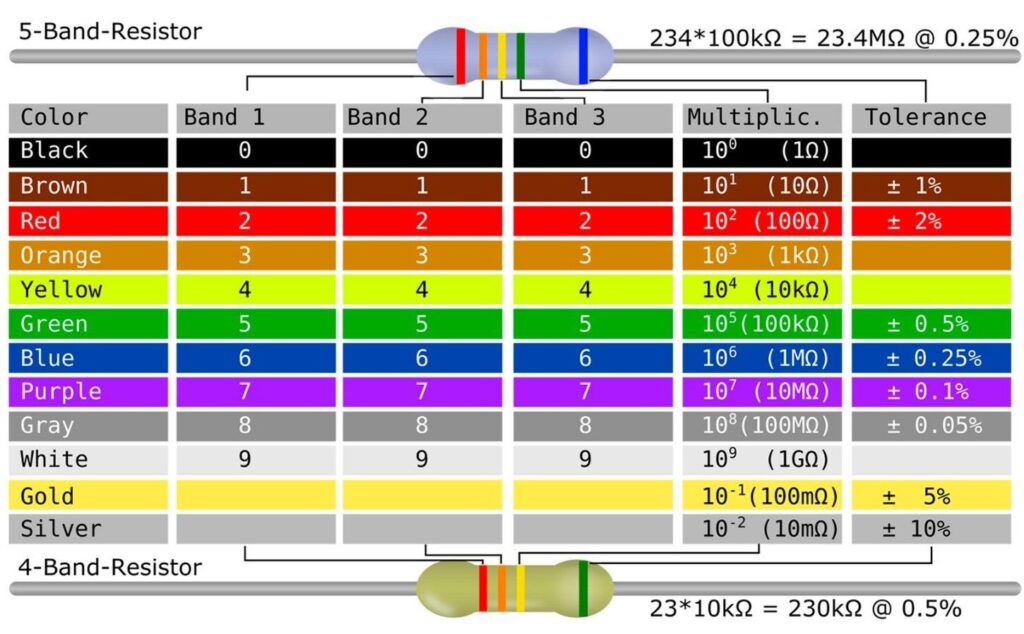Introduction
Resistors are important components of electrical circuits, used to reduce the current flowing through them. The value of a resistor can be determined using the colour code, which consists of coloured bands that indicate its resistance in ohms. In this blog post, we will go through the process of how to calculate the value of a resistor using the colour code.
The colour code
The colour code is the most popular method for reading resistor values. It uses a combination of coloured bands which indicate the resistance value of the resistor. The bands are arranged in a specific order and each band has a different meaning. The first two bands are the significant digits, while the third band is the multiplier. The fourth band indicates the tolerance or accuracy of the resistor.
Each colour is assigned a specific number value, as follows: black = 0, brown = 1, red = 2, orange = 3, yellow = 4, green = 5, blue = 6, violet = 7, gray = 8, white = 9. For example, if a resistor has brown-black-yellow-gold bands, then it has a value of 10 x 4,000 ohms (10kΩ).
The resistor value can be calculated by adding up the significant digits multiplied by the multiplier and then subtracting the tolerance. For example, if you have a resistor with brown-red-orange-silver bands, then the value is (1+2) x 1000 ohms = 3kΩ – 10%.
The tolerance percentage can also be calculated from the fourth band colour. Gold is +5%, silver is +10%, and no colour band means 20%. So in the example above, silver indicates 10% tolerance. Therefore the resistor has a value of 3kΩ – 10%.
Understanding the colour code and how to calculate the resistor values can help you determine the precise resistance value of any resistor quickly and easily.

The meaning of each colour
The colour code is used to determine the value of a resistor. Resistor reading can be done by looking at the bands of colours that are printed on the resistor. These bands can tell you the resistance, tolerance, and temperature coefficient of the resistor. The first two bands represent the first two digits in the resistor’s value. The third band represents the multiplier which determines how many zeros should follow the first two digits. The fourth band represents the tolerance which is a measure of how close the actual value of the resistor is to its nominal value. The fifth band, if present, represents the temperature coefficient.
The colours used for resistors are black, brown, red, orange, yellow, green, blue, violet, grey, white and gold or silver. Each colour represents a different numerical value as follows:black = 0, brown = 1, red = 2, orange = 3, yellow = 4, green = 5, blue = 6, violet = 7, grey = 8, white = 9 and gold or silver = +-5%.
For example, a resistor marked with the bands brown-black-orange-gold would have the value 10 x 10^3 ohms or 10k ohms with a tolerance of +-5%.
How to calculate the value of a resistor
Resistors are electrical components that are used to regulate the flow of current in circuits. The resistance of a resistor is indicated by its color code, which is usually printed on its body. To read the value of a resistor, you must first identify and understand the meaning of the colors that make up the resistor’s color code.
The first three color bands on a resistor represent the resistance value in ohms. The fourth band indicates the tolerance of the resistor, which is the amount of variance allowed in the actual resistance value. This will be either gold (5%) or silver (10%).
To calculate the value of a resistor, simply look at the first three bands and find their corresponding numbers on the resistor color code chart. For example, a resistor with three bands of brown, black, and red will have a value of 1K ohms, or 1000 ohms.
If you need to calculate the tolerance of a resistor, simply look at the fourth band and refer to the color code chart. For example, if the fourth band is gold, then the resistor will have a tolerance of 5%.
By understanding how to read resistor color codes and calculate the value and tolerance of a resistor, you can make sure that your circuits are functioning properly.
